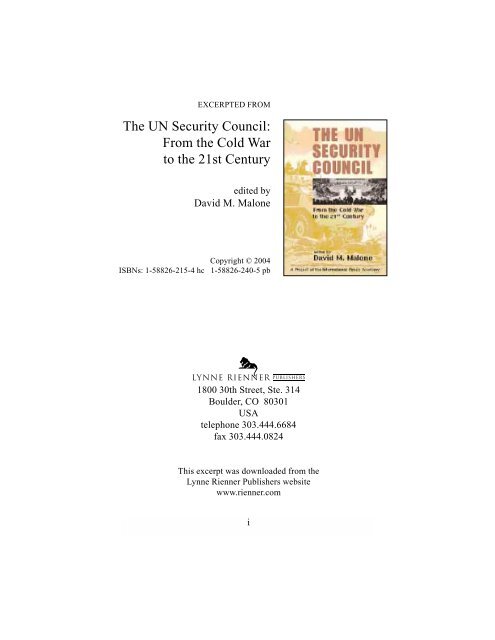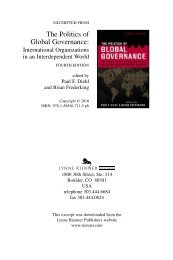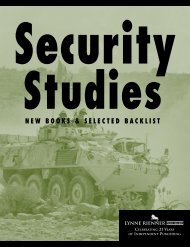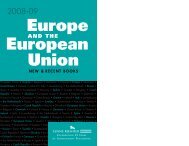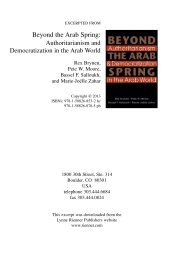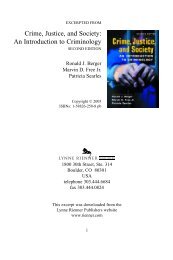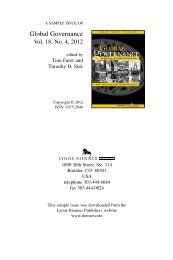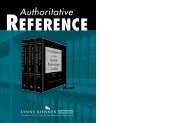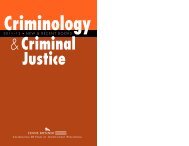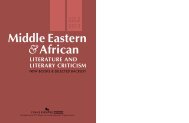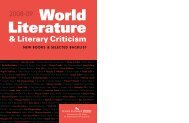The UN Security Council: From the Cold War to the 21st Century
The UN Security Council: From the Cold War to the 21st Century
The UN Security Council: From the Cold War to the 21st Century
Create successful ePaper yourself
Turn your PDF publications into a flip-book with our unique Google optimized e-Paper software.
EXCERPTED FROM<br />
<strong>The</strong> <strong>UN</strong> <strong>Security</strong> <strong>Council</strong>:<br />
<strong>From</strong> <strong>the</strong> <strong>Cold</strong> <strong>War</strong><br />
<strong>to</strong> <strong>the</strong> <strong>21st</strong> <strong>Century</strong><br />
edited by<br />
David M. Malone<br />
Copyright © 2004<br />
ISBNs: 1-58826-215-4 hc 1-58826-240-5 pb<br />
1800 30th Street, Ste. 314<br />
Boulder, CO 80301<br />
USA<br />
telephone 303.444.6684<br />
fax 303.444.0824<br />
This excerpt was downloaded from <strong>the</strong><br />
Lynne Rienner Publishers website<br />
www.rienner.com<br />
i
1<br />
Introduction<br />
DAVID M. MALONE<br />
Why this volume now? Much has changed for <strong>the</strong> United Nations <strong>Security</strong><br />
<strong>Council</strong> since <strong>the</strong> end of <strong>the</strong> <strong>Cold</strong> <strong>War</strong>. Its decisions—largely improvised<br />
and inconsistent though <strong>the</strong>y may be—have, for good and ill, profoundly<br />
affected international relations. Among o<strong>the</strong>r things, <strong>the</strong> <strong>Council</strong>’s decisions<br />
have eroded conceptions of state sovereignty firmly held during <strong>the</strong><br />
<strong>Cold</strong> <strong>War</strong> years, altering <strong>the</strong> way in which many of us see <strong>the</strong> relationship<br />
between state and citizen <strong>the</strong> world over.<br />
Two crises in international relations centered on Iraq, in 1990–1991<br />
and in 2002–2003, have led <strong>to</strong> two <strong>to</strong>tally different views of <strong>the</strong> <strong>UN</strong> in general<br />
and <strong>the</strong> <strong>Council</strong> in particular. Following <strong>the</strong> first, marked by <strong>the</strong> mobilization<br />
of many countries <strong>to</strong> eject Iraqi occupation forces from Kuwait<br />
under a strong <strong>Council</strong> mandate, extraordinary and unjustified euphoria<br />
<strong>to</strong>ok hold among practitioners and some scholars about <strong>the</strong> potential of <strong>the</strong><br />
<strong>UN</strong> <strong>to</strong> serve as <strong>the</strong> agent for <strong>the</strong> “new world order” advertised by President<br />
George H. W. Bush in 1990. At <strong>the</strong> time of <strong>the</strong> second crisis, obituaries<br />
were written for <strong>the</strong> <strong>UN</strong>, as well as for <strong>the</strong> idea of international order that it<br />
represents. In both cases, <strong>the</strong>se extreme views of <strong>the</strong> <strong>UN</strong> suggested that<br />
international practitioner, media, and scholarly opinion was not rooted in a<br />
sound understanding of what <strong>the</strong> <strong>Security</strong> <strong>Council</strong> is good at and what it is<br />
bad at. Moreover, <strong>the</strong>re was a general failure <strong>to</strong> understand how <strong>the</strong><br />
<strong>Council</strong> continues <strong>to</strong> coexist with an older form of international relations<br />
still based on sovereign states pursuing <strong>the</strong>ir various national interests. This<br />
volume seeks <strong>to</strong> give a rounded assessment of <strong>the</strong> strengths and weaknesses<br />
of <strong>the</strong> <strong>Council</strong> as an institution. It also seeks <strong>to</strong> identify what is novel and<br />
what may be enduring in its approaches <strong>to</strong> a widening agenda of international<br />
security issues since <strong>the</strong> end of <strong>the</strong> <strong>Cold</strong> <strong>War</strong>.<br />
Given <strong>the</strong> centrality of individual state interests at <strong>the</strong> <strong>UN</strong>, however<br />
unpalatable <strong>to</strong> some, <strong>the</strong> question arises as <strong>to</strong> whe<strong>the</strong>r <strong>the</strong> <strong>Council</strong>, in terms<br />
of <strong>the</strong> perceived legitimacy of its decisions, can be more than <strong>the</strong> sum of its<br />
1
2 INTRODUCTION<br />
parts. Perhaps <strong>the</strong> key driver in <strong>Council</strong> decisions <strong>to</strong>day, both actively and<br />
passively, is <strong>the</strong> agenda of <strong>the</strong> United States. This has raised questions<br />
about <strong>the</strong> extent <strong>to</strong> which <strong>the</strong> <strong>Council</strong> can resist (beyond <strong>the</strong> Iraq issue) <strong>the</strong><br />
“pull” of U.S. policy preferences. As of mid-2003, <strong>the</strong>re is also concern<br />
that <strong>the</strong> <strong>Council</strong> could find itself confined <strong>to</strong> mandating <strong>UN</strong> humanitarian,<br />
peacekeeping, and transitional government mop-up operations after U.S.-<br />
led military interventions. This tension—between military and political<br />
power and <strong>the</strong> power of legitimacy—runs through this volume.<br />
Aim and Scope<br />
It is hard enough <strong>to</strong> take a snapshot of <strong>the</strong> <strong>Council</strong>, with its long agenda,<br />
opaque proceedings, and uncertain impact on international relations, at any<br />
given time. Perhaps for this reason, <strong>the</strong> <strong>Council</strong> has not been addressed<br />
often o<strong>the</strong>r than through <strong>the</strong> lens of international law, a particular crisis, or<br />
one individual’s memoirs. Sidney Bailey and Sam Daws’s magisterial volume<br />
on <strong>the</strong> <strong>Council</strong>’s procedures, which also covers with great acuity a<br />
number of substantive issues, is <strong>the</strong> principal reference <strong>to</strong>ol for students of<br />
<strong>the</strong> <strong>Council</strong>. 1 O<strong>the</strong>r brief but incisive overviews were offered by Sir Brian<br />
Urquhart and <strong>the</strong> late Sir Anthony Parsons in <strong>the</strong> early 1990s, but <strong>the</strong>y are<br />
now mostly of his<strong>to</strong>rical interest. 2 <strong>The</strong> <strong>Council</strong> <strong>to</strong>day displays elements of<br />
continuity with <strong>the</strong> <strong>Council</strong> described so admirably by Andrew Boyd in<br />
Fifteen Men on a Powder Keg more than thirty years ago, not least with<br />
respect <strong>to</strong> <strong>the</strong> salience of national interest within it. 3 However, with <strong>the</strong><br />
geopolitical setting completely altered by <strong>the</strong> end of <strong>the</strong> <strong>Cold</strong> <strong>War</strong>, <strong>the</strong><br />
issues addressed by <strong>the</strong> <strong>Council</strong> and <strong>the</strong> way in which <strong>the</strong>y are addressed<br />
have evolved radically. Fur<strong>the</strong>rmore, <strong>the</strong> <strong>Council</strong> occasionally <strong>to</strong>day features<br />
female ambassadors, most recently including Madeleine Albright of<br />
<strong>the</strong> United States and Patricia Durant of Jamaica.<br />
By slicing and dicing in many different ways <strong>the</strong> <strong>Council</strong>’s decisions<br />
and activities, <strong>the</strong> substantive <strong>the</strong>mes of its work, and <strong>the</strong> institutional<br />
developments in its life, this volume attempts <strong>to</strong> assess its objectives and<br />
performance during <strong>the</strong> turbulent, frequently hyperactive years it has experienced<br />
in <strong>the</strong> post–<strong>Cold</strong> <strong>War</strong> era. <strong>The</strong> contribu<strong>to</strong>rs represent a mix of practitioners,<br />
many of whom have served on <strong>the</strong> <strong>Council</strong> or sought <strong>to</strong> implement<br />
its mandates; knowledgeable academics, a number of whom have<br />
published extensively on related <strong>to</strong>pics; and members of <strong>the</strong> community of<br />
nongovernmental organizations (NGOs) interacting frequently with <strong>the</strong><br />
<strong>Council</strong>.<br />
As in any endeavor of this type, even an ambitious and long one such<br />
as this, choices were required. <strong>The</strong> reader might wonder why we address<br />
certain trends and not o<strong>the</strong>rs—for example, why we do not offer a chapter<br />
on developments in peacekeeping. As <strong>to</strong>pics like this one are addressed in a
DAVID M. MALONE 3<br />
number of chapters from a variety of perspectives, we decided that offering<br />
a syn<strong>the</strong>sis chapter covering <strong>the</strong>m risked repetition. In o<strong>the</strong>r instances, we<br />
thought that a particular phenomenon or case, no matter how important or<br />
interesting in its own right, shed little more light on <strong>the</strong> workings and aims<br />
of <strong>the</strong> <strong>Council</strong> than did some o<strong>the</strong>r case offered in <strong>the</strong> volume. Accordingly,<br />
while we do present in Chapter 7 a thoughtful exploration by Elizabeth<br />
Cousens of <strong>the</strong> <strong>Council</strong>’s tentative and unconvincing approach <strong>to</strong> conflict<br />
prevention, we do not devote a chapter <strong>to</strong> peacebuilding (or “nation-building”<br />
as U.S. government officials sometimes refer <strong>to</strong> it) because a number<br />
of our case chapters deal with <strong>the</strong> inadequacies of <strong>the</strong> <strong>Council</strong>’s strategies<br />
<strong>to</strong> date for sustaining <strong>the</strong> peace it sometimes helps <strong>to</strong> establish. As for Iraq,<br />
its importance has been such within <strong>the</strong> <strong>Council</strong> that it is addressed in many<br />
of <strong>the</strong> chapters, centrally so in those on <strong>the</strong> use of force, weapons of mass<br />
destruction, and sanctions.<br />
Our Approach<br />
Our approach is not <strong>the</strong>oretically driven. When <strong>the</strong> contribu<strong>to</strong>rs met in<br />
January 2003, <strong>the</strong>y debated key issues pertaining <strong>to</strong> <strong>the</strong> <strong>Council</strong>, joined by<br />
a number of <strong>Council</strong> ambassadors. Helpfully urged on by Thomas M.<br />
Franck, we did consider a number of possible models for <strong>the</strong> <strong>Council</strong>’s role<br />
in international relations: an A<strong>the</strong>nian model, essentially consultative; a<br />
Congress of Vienna conclave model under which <strong>the</strong> <strong>Council</strong> is devoted <strong>to</strong><br />
norm-development, as many in Washing<strong>to</strong>n would have us believe is <strong>the</strong><br />
<strong>Council</strong>’s most characteristic trait <strong>to</strong>day; and a Roman model allowing for<br />
mobilizational governance—under this scheme, <strong>the</strong> <strong>Council</strong> serves as a<br />
senate constraining <strong>the</strong> emperor. In <strong>the</strong> post–<strong>Cold</strong> <strong>War</strong> era <strong>the</strong> Roman<br />
model may apply best, with <strong>the</strong> U.S. president cast as emperor, but contemporary<br />
his<strong>to</strong>ry is proving sufficiently fluid that we were not persuaded that<br />
any such <strong>the</strong>oretical approach would be profitable for this venture. We are<br />
content <strong>to</strong> let our research and conclusions serve as <strong>the</strong>ory fodder for<br />
o<strong>the</strong>rs.<br />
One snare for any writer on <strong>the</strong> <strong>Security</strong> <strong>Council</strong> relates <strong>to</strong> its identity.<br />
As a matter of convenience, authors sometimes refer <strong>to</strong> <strong>the</strong> <strong>Council</strong> when<br />
<strong>the</strong>y mean its members, a majority of its members, or only some of its<br />
members. Ano<strong>the</strong>r relates <strong>to</strong> assessments of <strong>UN</strong> “success” and “relevance.”<br />
Differences of appreciation will be clear throughout <strong>the</strong> volume and in its<br />
conclusions, being defined largely in <strong>the</strong> eye of individual beholders.<br />
<strong>The</strong> table of contents makes clear our approach <strong>to</strong> <strong>the</strong> s<strong>to</strong>ry. <strong>The</strong> first<br />
section focuses on fac<strong>to</strong>rs in <strong>Council</strong> decisionmaking that are new in <strong>the</strong><br />
post–<strong>Cold</strong> <strong>War</strong> era, often drivers of decisionmaking such as <strong>the</strong> humanitarian<br />
impulse or terrorism. We move on <strong>to</strong> focus for several chapters on one<br />
key change: <strong>the</strong> greater resort <strong>to</strong> <strong>the</strong> provisions of Chapter VII of <strong>the</strong> <strong>UN</strong>
4 INTRODUCTION<br />
Charter allowing for <strong>the</strong> enforcement measures of sanctions and <strong>the</strong> use of<br />
force. We <strong>the</strong>n offer ten chapters covering evolving institutional fac<strong>to</strong>rs<br />
affecting <strong>the</strong> <strong>Council</strong>, from <strong>the</strong> role of NGOs <strong>to</strong> pressures for <strong>Council</strong><br />
reform. In order <strong>to</strong> illustrate a number of <strong>the</strong>se <strong>the</strong>mes, we offer eleven<br />
brief case studies that we believe shed particular light on new approaches<br />
by <strong>the</strong> <strong>Council</strong>. In <strong>the</strong> final section, we seek <strong>to</strong> offer an interpretation and<br />
an integration of points raised in all <strong>the</strong>se chapters, doing justice <strong>to</strong> none of<br />
<strong>the</strong> contribu<strong>to</strong>rs singly, but aiming <strong>to</strong> offer one possible syn<strong>the</strong>sis of <strong>the</strong>ir<br />
views. In nei<strong>the</strong>r this introduction nor in <strong>the</strong> final section do we follow <strong>the</strong><br />
order of <strong>the</strong> table of contents; ra<strong>the</strong>r, we seek <strong>to</strong> isolate key crosscutting<br />
<strong>the</strong>mes.<br />
<strong>The</strong> End of <strong>the</strong> <strong>Cold</strong> <strong>War</strong> at <strong>the</strong> <strong>UN</strong><br />
How did <strong>the</strong> changes in <strong>the</strong> <strong>Council</strong> in <strong>the</strong> post–<strong>Cold</strong> <strong>War</strong> era come about?<br />
<strong>The</strong> <strong>Council</strong> initially viewed its role as preventing a third world war. As <strong>the</strong><br />
<strong>Cold</strong> <strong>War</strong> came <strong>to</strong> define global politics, <strong>the</strong> <strong>Council</strong> moved <strong>to</strong> tackle prevention<br />
of regional conflicts (often between client states or proxies of <strong>the</strong><br />
superpowers) from spilling in<strong>to</strong> a global conflagration. In this, <strong>the</strong> <strong>Council</strong><br />
made a helpful contribution on several occasions.<br />
One important signal of <strong>the</strong> decisive thaw in <strong>the</strong> <strong>Cold</strong> <strong>War</strong> was a<br />
noticeable improvement in <strong>the</strong> climate among <strong>the</strong> permanent five (P-5)<br />
members of <strong>the</strong> <strong>UN</strong> <strong>Security</strong> <strong>Council</strong> as of 1986. <strong>The</strong> first evidence of <strong>the</strong><br />
relaxation in East-West tensions within <strong>the</strong> <strong>Council</strong> was <strong>the</strong> cooperative<br />
manner in which <strong>the</strong>se countries discussed options for <strong>the</strong> position of <strong>UN</strong><br />
Secretary-General as Javier Pérez de Cuéllar’s first term drew <strong>to</strong> a close in<br />
1986.<br />
In late 1986, Sir John Thomson, <strong>the</strong> UK permanent representative <strong>to</strong><br />
<strong>the</strong> <strong>UN</strong>, <strong>to</strong>ok <strong>the</strong> initiative <strong>to</strong> call <strong>to</strong>ge<strong>the</strong>r <strong>the</strong> P-5 ambassadors, at his residence<br />
away from <strong>UN</strong> headquarters and delegation offices, for an informal<br />
discussion on how <strong>the</strong>y could contribute <strong>to</strong> an early end of <strong>the</strong> murderous<br />
Iran-Iraq <strong>War</strong>. 4 <strong>The</strong> o<strong>the</strong>rs welcomed this initiative, although China apparently<br />
remained reserved over P-5 activism for some time. A system of regular<br />
P-5 informal meetings soon <strong>to</strong>ok hold. <strong>The</strong>se meetings helped anticipate<br />
and defuse conflicts among <strong>the</strong> five and allowed <strong>the</strong>m <strong>to</strong> exchange notes on<br />
<strong>the</strong>ir national positions respecting various crises of <strong>the</strong> hour, if not formally<br />
<strong>to</strong> coordinate <strong>the</strong>ir positions.<br />
As it turned out, <strong>the</strong> P-5 agreed without much difficulty <strong>to</strong> a second<br />
term for <strong>the</strong> incumbent, who in January 1987 challenged <strong>the</strong>m publicly <strong>to</strong><br />
tackle resolution of <strong>the</strong> Iran-Iraq <strong>War</strong>. 5 As of mid-1987, <strong>Security</strong> <strong>Council</strong><br />
proposals for a cease-fire, moni<strong>to</strong>red by a small <strong>UN</strong> observer mission, were<br />
making serious headway. <strong>The</strong> post–<strong>Cold</strong> <strong>War</strong> era, initially such a hopeful<br />
one, had started at <strong>the</strong> <strong>UN</strong>.
DAVID M. MALONE 5<br />
Soviet president Mikhail Gorbachev’s celebrated Pravda and Izvestia<br />
article of September 17, 1987, seeking “wider use of . . . <strong>the</strong> institution of<br />
<strong>UN</strong> military observers and <strong>UN</strong> peacekeeping forces in disengaging <strong>the</strong><br />
troops of warring sides, observing cease-fires and armistice agreements,”<br />
called for <strong>the</strong> P-5 <strong>to</strong> become “guaran<strong>to</strong>rs” of international security. 6<br />
However, P-5 cooperation required some time <strong>to</strong> take root. 7<br />
Converging perspectives among <strong>the</strong> P-5 on a number of international<br />
crises, particularly on <strong>the</strong> need <strong>to</strong> disentangle <strong>the</strong> superpowers from <strong>the</strong>m,<br />
allowed <strong>the</strong> <strong>Council</strong> <strong>to</strong> initiate action <strong>to</strong>ward settlements. Between 1988<br />
and late 1989 it established five peacekeeping operations <strong>to</strong> assist <strong>the</strong> settlement<br />
of conflicts in Afghanistan (<strong>UN</strong>GOMAP) and between Iran and<br />
Iraq (<strong>UN</strong>IIMOG), <strong>to</strong> implement linked agreements on <strong>the</strong> withdrawal of<br />
Cuban troops in Angola (<strong>UN</strong>AVEM I) and independence for Namibia<br />
(<strong>UN</strong>TAG), and <strong>to</strong> help <strong>the</strong> resolution of three conflicts in Central America<br />
(ONUCA).<br />
While <strong>the</strong> end of <strong>the</strong> <strong>Cold</strong> <strong>War</strong> had <strong>to</strong> some extent already unlocked <strong>the</strong><br />
<strong>Council</strong>’s potential <strong>to</strong> contribute <strong>to</strong> <strong>the</strong> resolution of serious problems of<br />
international peace and security, drawing on newfound cooperation<br />
between <strong>the</strong> superpowers, <strong>the</strong> <strong>Council</strong>’s approach <strong>to</strong> conflicts remained relatively<br />
cautious until <strong>the</strong> Iraqi invasion of Kuwait in August 1990.<br />
Operation Desert S<strong>to</strong>rm and Its Immediate Aftermath<br />
This event, and Iraq’s formal annexation of Kuwait only days later, led <strong>the</strong><br />
<strong>Council</strong> <strong>to</strong> adopt a mandate authorizing <strong>the</strong> use of force by a coalition of<br />
member states. 8 <strong>Council</strong> decisions on Iraq, including measures adopted following<br />
<strong>the</strong> March 1991 end of hostilities <strong>to</strong> bring about <strong>the</strong> partial disarmament<br />
of Iraq, <strong>to</strong> encourage protection of Iraqi minorities, and <strong>to</strong> provide<br />
humanitarian assistance <strong>to</strong> <strong>the</strong> Kurdish population, were important not only<br />
in <strong>the</strong>ir own right but also because <strong>the</strong>y proved precedential in many<br />
respects. 9<br />
<strong>The</strong> success of <strong>the</strong> coalition’s military campaign against <strong>the</strong> Baghdad<br />
regime, in retrospect, appears <strong>to</strong> have induced an era of euphoria in <strong>the</strong><br />
<strong>Council</strong>, an era that could not have arisen during <strong>the</strong> <strong>Cold</strong> <strong>War</strong>. 10 Having<br />
successfully tackled a conceptually straightforward challenge <strong>to</strong> international<br />
peace and security in <strong>the</strong> form of Saddam Hussein’s attack on<br />
Kuwait, <strong>the</strong> <strong>Council</strong> now waded in<strong>to</strong> <strong>the</strong> murkier waters of civil wars and<br />
intercommunal strife, with which it had little experience. <strong>The</strong> <strong>Council</strong><br />
seemed <strong>to</strong> believe that because enforcement of its decisions against Iraq<br />
had been successfully carried out, <strong>the</strong> constraints on and limitations of <strong>UN</strong><br />
peacekeeping had fallen away. This era of euphoria can be described as<br />
lasting roughly between March 6, 1991, <strong>the</strong> date of Resolution 686, on <strong>the</strong><br />
end of hostilities in <strong>the</strong> Gulf region, and Oc<strong>to</strong>ber 13, 1993, when <strong>the</strong>
6 INTRODUCTION<br />
<strong>Council</strong> adopted Resolution 873 following <strong>the</strong> failure <strong>to</strong> deploy successfully<br />
<strong>the</strong> <strong>UN</strong> Mission in Haiti (<strong>UN</strong>MIH)—this only a week after <strong>the</strong> deaths of<br />
eighteen U.S. Army Rangers in Somalia had seriously undermined<br />
prospects for <strong>the</strong> sustainability <strong>the</strong>re of <strong>UN</strong>OSOM II. 11 <strong>The</strong> unique circumstances<br />
of <strong>the</strong> Gulf crisis, notably <strong>the</strong> threat that supplies of petroleum, <strong>the</strong><br />
lifeblood of <strong>the</strong> major Western economies, could be cut off, did not recur.<br />
Consequently, nei<strong>the</strong>r did <strong>the</strong> unity of purpose that characterized international<br />
response <strong>to</strong> Iraq’s attack on Kuwait. During this period of barely thirty-one<br />
months, <strong>the</strong> <strong>Council</strong> accelerated <strong>the</strong> pace of its work, adopting 185<br />
resolutions, versus 685 in <strong>the</strong> preceding forty-six years of <strong>UN</strong> his<strong>to</strong>ry, and<br />
launching fifteen new peacekeeping operations as compared <strong>to</strong> seventeen in<br />
<strong>the</strong> previous forty-six years. 12<br />
Building on an emerging view in much of <strong>the</strong> world that <strong>the</strong> <strong>UN</strong><br />
<strong>Security</strong> <strong>Council</strong> was at last coming in<strong>to</strong> its own, <strong>the</strong> first ever <strong>Security</strong><br />
<strong>Council</strong> summit was convened January 31, 1992, <strong>to</strong> discuss new orientations<br />
and activities for <strong>the</strong> <strong>Council</strong>. <strong>The</strong> summit’s statement, <strong>the</strong> high-water<br />
mark of enthusiasm over a purported new international order, noted (optimistically)<br />
that “<strong>the</strong> <strong>Security</strong> <strong>Council</strong> has begun <strong>to</strong> fulfill more effectively<br />
its primary responsibility for <strong>the</strong> maintenance of international peace and<br />
security.” 13<br />
Recently elected Secretary-General Boutros Boutros-Ghali responded<br />
with a wide-ranging, thoughtful, and ambitious document, An Agenda<br />
for Peace. This report advocated, inter alia, consideration in certain circumstances<br />
of a “preventive deployment” of <strong>UN</strong> peacekeepers <strong>to</strong> forestall<br />
hostilities known <strong>to</strong> be looming; and, when circumstances warranted,<br />
<strong>the</strong> use of force by <strong>the</strong> <strong>UN</strong> itself ra<strong>the</strong>r than by coalitions of member<br />
states. 14 An Agenda for Peace noted that peacekeeping had been carried<br />
out “hi<strong>the</strong>r<strong>to</strong>” with <strong>the</strong> consent of all parties, hinting that this might not<br />
be necessary in <strong>the</strong> future. It seemed <strong>to</strong> assume a quantum leap in <strong>the</strong><br />
willingness by member states <strong>to</strong> support <strong>UN</strong> action in <strong>the</strong> peace and<br />
security field.<br />
By January 1995, following serious setbacks in Bosnia and <strong>the</strong> inability<br />
<strong>to</strong> s<strong>to</strong>p <strong>the</strong> genocide in Rwanda, <strong>the</strong> <strong>UN</strong>’s most disastrous failure in<br />
decades, Boutros-Ghali, in <strong>the</strong> Supplement <strong>to</strong> an Agenda for Peace (more<br />
of a reassessment than an addendum), was sounding a more “realistic”<br />
note, drawing lessons from <strong>the</strong> <strong>UN</strong>’s experience on <strong>the</strong> ground over previous<br />
years: “Nei<strong>the</strong>r <strong>the</strong> <strong>Security</strong> <strong>Council</strong> nor <strong>the</strong> Secretary-General at present<br />
has <strong>the</strong> capacity <strong>to</strong> deploy, direct, command or control [enforcement]<br />
operations except perhaps on a very limited scale. . . . It would be folly <strong>to</strong><br />
attempt <strong>to</strong> do so at <strong>the</strong> present time when <strong>the</strong> Organization is resourcestarved<br />
and hard pressed <strong>to</strong> handle <strong>the</strong> less demanding peacemaking and<br />
peacekeeping responsibilities entrusted <strong>to</strong> it.” 15
DAVID M. MALONE 7<br />
Major Trends<br />
Emergence of <strong>the</strong> Permanent Five<br />
<strong>The</strong> much improved climate among <strong>the</strong> P-5 in <strong>the</strong> post–<strong>Cold</strong> <strong>War</strong> era can be<br />
gauged by <strong>the</strong> sharp decline in <strong>the</strong> use of <strong>the</strong> ve<strong>to</strong>: only 12 substantive<br />
ve<strong>to</strong>es were invoked from January 1990 <strong>to</strong> June 2003, compared <strong>to</strong> 193<br />
during <strong>the</strong> first forty-five years of <strong>the</strong> <strong>UN</strong>’s his<strong>to</strong>ry. 16 Ve<strong>to</strong> threats remained<br />
highly relevant, as <strong>the</strong> <strong>Council</strong>’s dealings on Kosovo in 1999 and Iraq in<br />
early 2003 make clear, but very few issues seriously divided <strong>the</strong> P-5 after<br />
1987 (<strong>the</strong> Arab-Israeli conflict remaining one of <strong>the</strong>m). <strong>The</strong> ability and disposition<br />
of <strong>the</strong> five permanent members—those holding ve<strong>to</strong> power—<strong>to</strong><br />
cooperate with each o<strong>the</strong>r seriously diminished <strong>the</strong> margin for maneuver of<br />
o<strong>the</strong>r <strong>Council</strong> members, as several chapters in this volume make clear (such<br />
as Chapter 16, on <strong>Council</strong> working methods, by Susan Hul<strong>to</strong>n, and several<br />
case studies by a variety of contribu<strong>to</strong>rs). Some of <strong>the</strong>m, including Finland<br />
and Canada, had in earlier times developed skills and occupied political<br />
space as “helpful fixers”; or, in <strong>the</strong> case of some developing nations, had<br />
learned how <strong>to</strong> play <strong>the</strong> permanent members against each o<strong>the</strong>r, greatly<br />
amplifying <strong>the</strong> voice and enhancing <strong>the</strong> apparent influence of <strong>the</strong> nonaligned<br />
movement within <strong>the</strong> <strong>Council</strong>. 17<br />
Soon, however, elected members were grumbling that <strong>the</strong>y were systematically<br />
marginalized, a complaint given more weight by a tendency of<br />
<strong>the</strong> Secretariat <strong>to</strong> consult privately with some or all of <strong>the</strong> P-5 before<br />
advancing recommendations <strong>to</strong> <strong>the</strong> <strong>Council</strong> as a whole. Chapter 17, on relations<br />
between permanent and elected members of <strong>the</strong> <strong>Council</strong>, by Kishore<br />
Mahbubani, an ambassador representing a nonpermanent member of <strong>the</strong><br />
<strong>Council</strong>, makes clear why this dynamic is grating and may have proved<br />
counterproductive over time. Tacit collusion between <strong>the</strong> P-5 and <strong>the</strong><br />
Secretariat was aggravated, from <strong>the</strong> perspective of o<strong>the</strong>r members, by <strong>the</strong><br />
growing resort <strong>to</strong> “informal consultations” for decisionmaking purposes<br />
ra<strong>the</strong>r than <strong>the</strong> open <strong>Council</strong> meetings that had served as <strong>the</strong> principal<br />
forum for <strong>Council</strong> decisionmaking in earlier decades. 18 High-handed<br />
behavior by <strong>the</strong> P-5 reached a zenith in December 2002, when <strong>the</strong> United<br />
States forced <strong>the</strong> <strong>Council</strong> presidency <strong>to</strong> reverse a <strong>Council</strong> decision on<br />
access <strong>to</strong> a report by <strong>UN</strong>MOVIC and inspec<strong>to</strong>rs of <strong>the</strong> International A<strong>to</strong>mic<br />
Energy Agency, insisting on differentiated arrangements for permanent and<br />
elected members, a highly undignified (and unusually public) process<br />
widely denounced, not least by Kofi Annan. 19<br />
<strong>The</strong> P-5 do not “manage” <strong>the</strong> <strong>Council</strong>, although <strong>the</strong>y do dominate it,<br />
not least by monopolizing most of <strong>the</strong> drafting. Scheduling is coordinated<br />
by <strong>the</strong> presidency, and individual agenda items have increasingly been<br />
managed by limited-membership steering groups, often “Groups of
8 INTRODUCTION<br />
Friends” (generally but not always composed of <strong>Council</strong> and recent past<br />
<strong>Council</strong> members), who along with <strong>the</strong> Secretary-General propose options<br />
and preferred courses of action <strong>to</strong> <strong>the</strong> <strong>Council</strong> as a whole. Teresa Whitfield<br />
examines this important, often controversial, recent development in<br />
Chapter 21.<br />
<strong>The</strong> Permanent One<br />
It would be misleading <strong>to</strong> suggest that <strong>the</strong> P-5 are not only often cohesive<br />
but also equal. It has been clear for some years, perhaps mostly strikingly<br />
so since <strong>the</strong> Day<strong>to</strong>n Accords of late 1995, that <strong>the</strong> United States has<br />
emerged not only as <strong>the</strong> sole remaining superpower but also as <strong>the</strong> principal<br />
driver of <strong>the</strong> <strong>Council</strong>’s agenda and decisions, passively and actively. This<br />
development introduced new challenges in<strong>to</strong> management of <strong>the</strong> <strong>Council</strong>’s<br />
goals, work, and decisions, for both good and ill, as discussed by Nathan<br />
Miller and Frederick Rawski in Chapter 24, on <strong>the</strong> U.S. relationship with<br />
<strong>the</strong> <strong>Security</strong> <strong>Council</strong>, sometimes described elsewhere as an effort at dual<br />
containment. 20<br />
An Expanding Agenda: Substantive Innovation<br />
<strong>The</strong> post–<strong>Cold</strong> <strong>War</strong> period has been marked by <strong>the</strong> <strong>Council</strong>’s disposition <strong>to</strong><br />
tackle many more conflicts than it had been able <strong>to</strong> earlier, when it was<br />
stymied by East-West animosities and <strong>the</strong> plethora of ve<strong>to</strong>es (cast and<br />
threatened) by <strong>the</strong> permanent members. <strong>The</strong> end of <strong>the</strong> <strong>Cold</strong> <strong>War</strong> unlocked<br />
implementation of <strong>the</strong> <strong>Council</strong>’s earlier decisions on Namibia, as documented<br />
in Chapter 27 in Cedric Thornberry’s gripping account of this early<br />
episode of <strong>UN</strong>-controlled transitional arrangements. Since 1990 <strong>the</strong>re have<br />
been momen<strong>to</strong>us shifts in <strong>the</strong> <strong>Council</strong>’s approach <strong>to</strong> conflict and its resolution.<br />
Fac<strong>to</strong>rs held by <strong>the</strong> <strong>Council</strong> as constituting a threat <strong>to</strong> international<br />
peace expanded <strong>to</strong> include a coup against a democratically elected regime<br />
(documented in Chapter 31, on Haiti, coauthored by Sebastian von<br />
Einsiedel and myself, and in Chapter 5, on democratization, by Gregory<br />
Fox); a range of humanitarian catastrophes (discussed in Chapter 30, on<br />
Bosnia, by Mats Berdal, and in Chapter 35, on East Timor, by Stewart<br />
Eldon), particularly those generating large outflows of displaced persons<br />
and refugees, internally and internationally (as discussed in Chapter 3 by<br />
Thomas Weiss); and acts of terrorism (as cataloged in Chapter 6 by Edward<br />
Luck). 21 Steven Ratner, in Chapter 37, on <strong>the</strong> role of <strong>the</strong> <strong>Council</strong> in international<br />
law, explores some of <strong>the</strong> relevant issues.<br />
This, in turn, allowed <strong>the</strong> <strong>Council</strong> <strong>to</strong> act on a range of conflicts, mostly<br />
internal in nature, which it most likely would have avoided in <strong>the</strong> past,<br />
when <strong>the</strong> <strong>Cold</strong> <strong>War</strong> antagonists often played out <strong>the</strong>ir hostility through<br />
regional proxies and were prepared <strong>to</strong> frustrate <strong>Council</strong> involvement. <strong>The</strong>se
DAVID M. MALONE 9<br />
included conflicts in El Salvador (discussed in Chapter 28 by Blanca<br />
An<strong>to</strong>nini); Sierra Leone (detailed in Chapter 33 by John Hirsch); <strong>the</strong> former<br />
Yugoslavia (dealt with in this volume most directly by Mats Berdal in<br />
Chapter 30, and Paul Heinbecker in Chapter 34); Mozambique (dissected in<br />
Chapter 29 by Aldo Ajello and Patrick Wittmann); and Rwanda (discussed<br />
in Chapter 32 by Howard Adelman and Astri Suhrke, and enriched by separate<br />
insider accounts from Colin Keating and Ibrahim Gambari in Chapters<br />
32.1 and 32.2). In many of <strong>the</strong>se conflicts, <strong>the</strong> <strong>Security</strong> <strong>Council</strong> found itself<br />
contending with armed nonstate ac<strong>to</strong>rs, a new phenomenon addressed here<br />
in Chapter 8 by Andrés Franco. <strong>The</strong> <strong>Council</strong>’s decisions in <strong>the</strong> 1990s<br />
proved highly innovative in shaping <strong>the</strong> normative framework for international<br />
relations and stimulated several radical legal developments at <strong>the</strong><br />
international level, notably <strong>the</strong> creation of international criminal tribunals<br />
for <strong>the</strong> former Yugoslavia and Rwanda in 1993 and 1994 respectively. This<br />
greatly intensified pressure for a more universal International Criminal<br />
Court (ICC), a statute for which was adopted at a diplomatic conference in<br />
Rome in 1998. <strong>The</strong>se developments are covered in this volume by ICC<br />
judge Philippe Kirsch, John Holmes, and Mora Johnson in Chapter 19. As<br />
Cameron Hume argues in Chapter 38, <strong>the</strong> <strong>Council</strong> will have <strong>to</strong> continue <strong>to</strong><br />
be creative in adapting <strong>to</strong> new challenges posed by failing states and<br />
transnational threats.<br />
Interstate conflicts did not al<strong>to</strong>ge<strong>the</strong>r cease <strong>to</strong> break out, as Chapter 36<br />
by Adekeye Adebajo, on <strong>the</strong> Ethiopia-Eritrea conflict of <strong>the</strong> late 1990s,<br />
demonstrates. However, with very few exceptions, <strong>the</strong> wreckage of <strong>the</strong><br />
<strong>Cold</strong> <strong>War</strong> was successfully addressed once <strong>the</strong> superpower confrontation<br />
came <strong>to</strong> an end. Certain conflicts of an earlier era, such as <strong>the</strong> Israeli-Arab<br />
dispute, addressed by Bruce Jones in Chapter 26, and <strong>the</strong> worrying tensions<br />
over Kashmir, still bedevil <strong>the</strong> international agenda, but <strong>the</strong>y are rare. Peter<br />
Wallensteen and Patrik Johansson, in Chapter 2, make clear that, contrary<br />
<strong>to</strong> media and public perceptions, conflict is on <strong>the</strong> decline and <strong>the</strong>re are few<br />
reasons <strong>to</strong> harbor nostalgia for <strong>the</strong> nuclear terror–induced “stability” of <strong>the</strong><br />
<strong>Cold</strong> <strong>War</strong>.<br />
An intriguing trend relates <strong>to</strong> <strong>the</strong> <strong>Council</strong>’s role in mandating <strong>UN</strong> roles<br />
in <strong>the</strong> oversight of terri<strong>to</strong>ries. This occurred not only in Namibia and<br />
Eastern Slavonia but also, in a less comprehensive form, in Cambodia and<br />
Bosnia. It reached its zenith in Kosovo, <strong>to</strong>uched upon in Chapter 34 by<br />
Paul Heinbecker, and East Timor, covered in Chapter 35 by Stewart Eldon<br />
and supplemented in Chapter 35.1 with a separate view from <strong>the</strong> field by<br />
Ian Martin. <strong>The</strong> <strong>Council</strong>’s role in mandating such “virtual trusteeships” is<br />
discussed in Chapter 15 in a crosscutting manner by Simon Chesterman.<br />
Never<strong>the</strong>less, in <strong>the</strong> late 1990s, serious tensions resurfaced in <strong>the</strong><br />
<strong>Council</strong> over issues relating <strong>to</strong> state sovereignty, legitimation of <strong>the</strong> use of<br />
force, and <strong>the</strong> growing incidence of unilateralism by some major <strong>UN</strong> mem-
10 INTRODUCTION<br />
bers. Differences crystallized in 1998 and 1999 over conflicting objectives<br />
and approaches among <strong>the</strong> P-5 <strong>to</strong> Iraq and Kosovo. While discord over<br />
Kosovo was contained by agreement on <strong>the</strong> parameters of a <strong>UN</strong>-administered<br />
transitional regime in this terri<strong>to</strong>ry, <strong>the</strong> agreement was achieved at <strong>the</strong><br />
price of lack of clarity over future constitutional arrangements and could<br />
hold <strong>the</strong> seeds of future problems. Iraq remained highly nettlesome, with<br />
<strong>the</strong> P-5 coming <strong>to</strong>ge<strong>the</strong>r on key resolutions such as 1284 and 1441, but ultimately<br />
deadlocked by mid-March 2003, when military action against Iraq<br />
was initiated by <strong>the</strong> United States and several of its allies.<br />
<strong>The</strong> ebb and flow of <strong>Council</strong> business has tended <strong>to</strong> obscure <strong>the</strong> extent<br />
<strong>to</strong> which its decisions cumulatively since 1990 have undermined rigid conceptions<br />
of state sovereignty and eroded <strong>the</strong> position of governments claiming<br />
<strong>the</strong> sovereign right <strong>to</strong> conduct <strong>the</strong>mselves at home free of international<br />
interference, even on matters that could undermine domestic security and<br />
<strong>the</strong> stability not only of <strong>the</strong>ir own countries but eventually of neighboring<br />
ones (for example, by massively abusing human rights or engaging in ethnic<br />
engineering or cleansing).<br />
Chapter VII of <strong>the</strong> <strong>UN</strong> Charter<br />
Prior <strong>to</strong> 1990 <strong>the</strong>re was little resort <strong>to</strong> those provisions in <strong>the</strong> <strong>UN</strong> Charter<br />
relating <strong>to</strong> <strong>the</strong> coercive measures <strong>the</strong> <strong>Council</strong> can invoke. Manda<strong>to</strong>ry sanctions<br />
were imposed by <strong>the</strong> <strong>Council</strong> in only two instances: Sou<strong>the</strong>rn<br />
Rhodesia in 1966 and South Africa in 1977. A naval blockade <strong>to</strong> enforce<br />
<strong>the</strong> Rhodesia sanctions regime was authorized but rapidly failed once it<br />
became clear that force would not be used <strong>to</strong> back it up. <strong>The</strong> use of force<br />
itself was explicitly authorized only in <strong>the</strong> case of Korea in <strong>the</strong> early 1950s<br />
(in <strong>the</strong> absence from <strong>the</strong> <strong>Council</strong> of <strong>the</strong> Soviet Union), and in a much more<br />
tentative and limited way in <strong>the</strong> Congo in <strong>the</strong> early 1960s. <strong>The</strong> latter<br />
episode was not widely considered a success, confirming in many <strong>the</strong> view<br />
that <strong>the</strong> use of force should be avoided by <strong>the</strong> <strong>Council</strong> in its decisionmaking.<br />
With <strong>the</strong> new mood among <strong>the</strong> P-5, <strong>the</strong> <strong>Council</strong>, with several<br />
intractable conflicts on its agenda, moved rapidly in <strong>the</strong> post–<strong>Cold</strong> <strong>War</strong> era<br />
<strong>to</strong> impose its will on a range of international ac<strong>to</strong>rs through a dizzying<br />
array of sanctions regimes (occasionally backed up by naval blockades)<br />
discussed in Chapter 11 by David Cortright and George Lopez and through<br />
<strong>the</strong> frequent authorization of force, both by troops under <strong>UN</strong> command and<br />
by coalitions of member states. In Chapter 13, David Angell adds a personal<br />
comment on Canada’s efforts <strong>to</strong> ensure a degree of enforcement of <strong>the</strong><br />
sanctions regime against <strong>UN</strong>ITA in Angola. New issues, such as internal<br />
disarmament, became subject <strong>to</strong> enforcement, notably in Iraq as discussed<br />
in admirably dispassionate fashion by Pascal Teixeira da Silva in Chapter
DAVID M. MALONE 11<br />
14. Adam Roberts discusses in Chapter 9 <strong>the</strong> links between <strong>the</strong> use of force,<br />
international law, and <strong>the</strong> authority of <strong>the</strong> security council, while Frank<br />
Berman dissects in Chapter 10 perhaps <strong>the</strong> most famous of <strong>the</strong> enforcement<br />
resolutions, 678 of November 1990, on Iraq. Chapter VII decisions occasionally<br />
gave rise <strong>to</strong> significant tensions among <strong>the</strong> permanent five, as documented<br />
in Chapter 12 by Peter van Walsum in a personal account of his<br />
two years as chair of <strong>the</strong> <strong>Council</strong>’s Iraq sanctions committee. Much of this<br />
struggle unfolded privately, although insightful reporting by Colum Lynch<br />
of <strong>the</strong> Washing<strong>to</strong>n Post and Carola Hoyos of <strong>the</strong> Financial Times occasionally<br />
revealed it through <strong>the</strong> media.<br />
While <strong>the</strong> <strong>Council</strong>’s assertive exploration of <strong>the</strong> Chapter VII provisions<br />
initially seemed <strong>to</strong> hold out <strong>the</strong> hope that a new world order could be constructed<br />
with <strong>the</strong> <strong>UN</strong> at its center, many of <strong>the</strong> coercive strategies of <strong>the</strong><br />
<strong>Council</strong> failed because of <strong>the</strong> application of insufficient or inappropriate<br />
resources, wishful thinking, and a flight from reality that seemed <strong>to</strong> overtake<br />
<strong>the</strong> <strong>Council</strong> in <strong>the</strong> years 1992–1995. Doubtless a sense of individual<br />
responsibility of member states was seriously undermined by <strong>the</strong> mechanics<br />
and compromises of committee decisionmaking, but several instances<br />
of spectacular <strong>Council</strong> failure seem no less lurid years later than <strong>the</strong>y did in<br />
<strong>the</strong> headlines of <strong>the</strong> day, notably those arising from <strong>the</strong> <strong>UN</strong>’s involvement<br />
in Bosnia, Somalia, and Rwanda.<br />
Because of a greater resort <strong>to</strong> <strong>the</strong> <strong>Council</strong> <strong>to</strong> authorize <strong>the</strong> use of force<br />
internationally, but also because of a noticeable tendency <strong>to</strong> avoid doing so<br />
in certain cases, arguments have grown that, even beyond narrowly constructed<br />
cases of self-defense, explicit <strong>Council</strong> authorization for <strong>the</strong> use of<br />
force may no longer be required, however politically useful it can prove.<br />
Institutional Fac<strong>to</strong>rs<br />
During its early decades, <strong>the</strong> <strong>Council</strong> had few institutional partners. This<br />
has changed radically since <strong>the</strong> early 1990s. Today, due <strong>to</strong> limited resources<br />
and for reasons of substantive burden-sharing, <strong>the</strong> <strong>Council</strong>’s decisions often<br />
foresee cooperation with regional organizations (broadly defined <strong>to</strong> include<br />
such institutions as NATO as well as more classic regional organizations as<br />
originally envisaged in Chapter VIII of <strong>the</strong> <strong>UN</strong> Charter). This trend is discussed<br />
in Chapter 20 by Shepard Forman and Andrew Grene. NGOs have<br />
also come <strong>to</strong> play an important role, although a largely unheralded one, in<br />
<strong>the</strong> <strong>Council</strong>’s life. James Paul discusses aspects of this development in<br />
Chapter 25, as does Joanna Weschler in Chapter 4, on human rights in <strong>the</strong><br />
life of <strong>the</strong> <strong>Council</strong>.<br />
<strong>The</strong> relationship between <strong>the</strong> Secretary-General and <strong>the</strong> <strong>Security</strong><br />
<strong>Council</strong> is explored in Chapter 18 by Marrack Goulding, <strong>the</strong> <strong>UN</strong>’s premier<br />
negotia<strong>to</strong>r for many years, who contrasts <strong>the</strong> tenure of Secretary-General
12 INTRODUCTION<br />
Boutros Boutros-Ghali (1992–1996) with that of Secretary-General Javier<br />
Pérez de Cuéllar (1982–1991). He (and Mahbubani) make clear that <strong>the</strong><br />
Secretariat’s relationship with <strong>the</strong> <strong>Council</strong> is often intermediated by <strong>the</strong> P-<br />
5. In Chapter 22, Connie Peck offers an account of that increasingly ubiqui<strong>to</strong>us<br />
figure in international relations, <strong>the</strong> special representative of <strong>the</strong> <strong>UN</strong><br />
Secretary-General, mostly responsible for overseeing complex peace operations<br />
or mediation efforts in <strong>the</strong> field. <strong>The</strong> <strong>Council</strong>’s relationship with <strong>the</strong>se<br />
individuals has varied in form and substance but is increasingly recognized<br />
as important. In a <strong>Council</strong> retreat during December 2002, extensive discussion<br />
occurred on <strong>the</strong> function and importance of appropriate incumbents. 22<br />
With <strong>the</strong> more active role played by <strong>the</strong> <strong>Council</strong> in international relations<br />
has come pressure for <strong>Council</strong> reform under several headings: its<br />
working methods, composition, and <strong>the</strong> ve<strong>to</strong> all came under heavy criticism<br />
as of <strong>the</strong> early 1990s. However, pressure for reform has achieved little<br />
change beyond <strong>the</strong> <strong>Council</strong>’s increasingly open working methods, as discussed<br />
by Bardo Fassbender in Chapter 23, and <strong>the</strong>re is little prospect of<br />
early agreement among <strong>the</strong> membership on significant change in years <strong>to</strong><br />
come, not least because it is widely accepted that <strong>the</strong>re is a tradeoff<br />
between expansion of <strong>the</strong> <strong>Council</strong>, <strong>to</strong> achieve a more representative composition,<br />
and effectiveness of <strong>the</strong> body, which continues <strong>to</strong> be much prized by<br />
a number of powerful governments. While most countries have developed a<br />
scheme for <strong>Council</strong> reform perfectly tailored <strong>to</strong> maximizing <strong>the</strong>ir own situation<br />
with respect <strong>to</strong> a reformed <strong>Council</strong>, <strong>the</strong>ir preferred fallback is not<br />
some o<strong>the</strong>r country’s scheme but <strong>the</strong> status quo.<br />
<strong>The</strong> Media<br />
<strong>The</strong> media play an important role in <strong>the</strong> life of <strong>the</strong> <strong>Council</strong>, often producing<br />
international pressure for action <strong>to</strong> address man-made disasters or <strong>to</strong> head<br />
off cataclysms, including those concerning North Korea and Iraq and<br />
potentially involving weapons of mass destruction. <strong>The</strong> Cable News<br />
Network (CNN) has often been described as <strong>the</strong> <strong>Council</strong>’s “sixteenth member,”<br />
and its <strong>UN</strong> bureau has done much through its weekly program<br />
“Diplomatic License” <strong>to</strong> make <strong>the</strong> <strong>Council</strong> and its decisions better unders<strong>to</strong>od.<br />
<strong>The</strong> British Broadcasting Corporation (BBC) has consistently sought<br />
<strong>to</strong> interpret insightfully iconic images of <strong>Council</strong> ambassadors meeting in<br />
<strong>the</strong> fabled <strong>Council</strong> chamber and <strong>the</strong>n delivering <strong>the</strong>mselves of competitive<br />
but often misleading (and soon forgotten) pronouncements on <strong>the</strong> proceedings.<br />
<strong>The</strong> media influence <strong>the</strong> <strong>Council</strong> most strongly through its member<br />
states. Governments react <strong>to</strong> public pressure, largely shaped by <strong>the</strong> media.<br />
Governments mostly like <strong>to</strong> tax and spend. By and large, <strong>the</strong>y are averse <strong>to</strong><br />
risk. Thus, when international crises develop and public pressure <strong>to</strong> address
DAVID M. MALONE 13<br />
<strong>the</strong>m builds through <strong>the</strong> media, a default option for governments is <strong>to</strong> delegate<br />
<strong>to</strong> multilateral organizations such as <strong>the</strong> <strong>UN</strong> <strong>the</strong> responsibility <strong>to</strong><br />
respond.<br />
That said, media reporting of <strong>the</strong> <strong>Council</strong> itself is mostly reactive and<br />
event-driven. <strong>The</strong> <strong>Council</strong>’s “home” broadsheet, <strong>the</strong> New York Times, has<br />
given it considerable attention, often in commendable depth through <strong>the</strong><br />
writing of Barbara Crossette and James Traub. <strong>The</strong> Paris daily Le Monde<br />
has also done an excellent job of looking beyond <strong>the</strong> wire service headlines,<br />
and <strong>the</strong> Financial Times has fielded talented correspondents at <strong>the</strong><br />
<strong>UN</strong>. 23 However, <strong>the</strong>re may not be much more <strong>to</strong> be said, and we consequently<br />
do not offer a chapter specifically covering this <strong>to</strong>pic.<br />
Envoi<br />
In order <strong>to</strong> set <strong>the</strong> stage, Peter Wallensteen, one of <strong>the</strong> world’s foremost<br />
thinkers on both <strong>the</strong> nature and <strong>the</strong> pattern of violent conflicts <strong>to</strong>day,<br />
<strong>to</strong>ge<strong>the</strong>r with Patrik Johansson, discusses in Chapter 2 <strong>the</strong> trends in <strong>Council</strong><br />
decisions in recent years. <strong>The</strong>reafter, as outlined above, we address a number<br />
of individual fac<strong>to</strong>rs and cases relevant <strong>to</strong> <strong>the</strong> <strong>Council</strong>’s performance in<br />
<strong>the</strong> post–<strong>Cold</strong> <strong>War</strong> era. Our conclusions aim <strong>to</strong> offer a range of broader <strong>the</strong>matic<br />
observations.<br />
Notes<br />
1. Sydney D. Bailey and Sam Daws, <strong>The</strong> Procedure of <strong>the</strong> <strong>Security</strong> <strong>Council</strong>,<br />
3rd ed. (Oxford: Clarendon, 1998).<br />
2. Brian Urquhart, “<strong>The</strong> <strong>UN</strong> and International <strong>Security</strong> after <strong>the</strong> <strong>Cold</strong> <strong>War</strong>,”<br />
and Anthony Parsons, “<strong>The</strong> <strong>UN</strong> and <strong>the</strong> National Interests of States,” in Adam<br />
Roberts and Benedict Kingsbury, eds., United Nations, Divided World: <strong>The</strong> <strong>UN</strong>’s<br />
Roles in International Relations, 2nd ed. (Oxford: Clarendon, 1993), pp. 81–124.<br />
3. Andrew Boyd, Fifteen Men on a Powder Keg: A His<strong>to</strong>ry of <strong>the</strong> <strong>UN</strong><br />
<strong>Security</strong> <strong>Council</strong> (New York: Stein and Day, 1971).<br />
4. For an account of evolving dynamics within <strong>the</strong> <strong>UN</strong> <strong>Security</strong> <strong>Council</strong>, particularly<br />
among <strong>the</strong> P-5, 1986–1990, see Cameron Hume, <strong>The</strong> United Nations, Iran,<br />
and Iraq: How Peacemaking Changed (Blooming<strong>to</strong>n: University of Indiana Press,<br />
1994), esp. pp. 81–82, 88–102.<br />
5. SG/SM/3956, January 13, 1987, p. 5.<br />
6. Mikhail S. Gorbachev, “Reality and <strong>the</strong> Guarantees of a Secure World,”<br />
FBIS Daily Report: Soviet Union, September 17, 1987, pp. 23–28.<br />
7. Interviews with Alexander M. Belonogov, permanent representative of <strong>the</strong><br />
USSR <strong>to</strong> <strong>the</strong> <strong>UN</strong>, 1986–1990, and John Thomson, permanent representative of <strong>the</strong><br />
UK <strong>to</strong> <strong>the</strong> <strong>UN</strong>, 1982–1987, conducted respectively in Ottawa on March 20, 1996,<br />
and in Prince<strong>to</strong>n on April 15, 1996.<br />
8. Resolution 678, November 29, 1990. Operation Desert S<strong>to</strong>rm originally<br />
was confined <strong>to</strong> aerial attacks on Iraq. <strong>The</strong> broader military campaign was designated<br />
as Operation Desert Saber, but <strong>the</strong> moniker Desert S<strong>to</strong>rm eventually displaced it.
14 INTRODUCTION<br />
9. A number of <strong>the</strong> measures adopted by France, <strong>the</strong> UK, <strong>the</strong> United States,<br />
and <strong>the</strong>ir allies, particularly in nor<strong>the</strong>rn Iraq (<strong>to</strong> protect, through a no-fly zone, and<br />
provide assistance <strong>to</strong> <strong>the</strong> Kurds), were initiated without explicit <strong>Council</strong> authorization.<br />
<strong>The</strong>se measures were, however, not <strong>the</strong>n seriously challenged within <strong>the</strong><br />
<strong>Council</strong>. Some of <strong>the</strong> humanitarian activities of Operation Provide Comfort were<br />
eventually taken over by <strong>the</strong> <strong>UN</strong>.<br />
10. Contributing importantly <strong>to</strong> <strong>the</strong> unity of <strong>the</strong> international community in<br />
confronting Saddam Hussein in 1990 was an impressive diplomatic campaign by<br />
President George H. W. Bush, his secretary of state, James Baker, and <strong>the</strong>ir skilled<br />
U.S. ambassador at <strong>the</strong> <strong>UN</strong>, Thomas Pickering, <strong>to</strong> assemble a formidable diplomatic<br />
coalition <strong>to</strong> this end. <strong>The</strong>se conditions were not reproduced in 2002 when <strong>the</strong><br />
United States sought <strong>to</strong> increase pressure on <strong>the</strong> Baghdad regime.<br />
11. Resolution 873 reimposed sanctions on Haiti.<br />
12. During this period, <strong>the</strong> <strong>UN</strong> launched <strong>the</strong> following new peacekeeping<br />
operations: <strong>UN</strong>IKOM in Kuwait (1991), MINURSO for Western Sahara (1991),<br />
ONUSAL in El Salvador (1991), <strong>UN</strong>AVEM II in Angola (1991), <strong>UN</strong>AMIC in<br />
Cambodia (1991), <strong>UN</strong>PROFOR in <strong>the</strong> former Yugoslavia (1992), <strong>UN</strong>TAC in<br />
Cambodia (1992), <strong>UN</strong>OSOM in Somalia (1992), ONUMOZ in Mozambique<br />
(1992), <strong>UN</strong>OSOM II (1993), <strong>UN</strong>OMUR in Uganda-Rwanda (1993), <strong>UN</strong>OMIG in<br />
Georgia (1993), <strong>UN</strong>OMIL in Liberia (1993), <strong>UN</strong>MIH in Haiti (1993), and<br />
<strong>UN</strong>AMIR in Rwanda (1993). In addition, <strong>the</strong> <strong>Council</strong> authorized <strong>the</strong> U.S.-led<br />
Unified Task Force in Somalia (<strong>UN</strong>ITAF, 1992), and a <strong>UN</strong>PROFOR presence, in<br />
effect a preventive deployment, in Macedonia (1992).<br />
13. S/23500, January 31, 1992, p. 2.<br />
14. A/47/277, June 17, 1992.<br />
15. A/50/60, January 3, 1995, p. 18.<br />
16. All ve<strong>to</strong>es since May 1990 were by <strong>the</strong> United States (mostly on <strong>the</strong><br />
Israeli-Palestinian struggle), except for two by Russia (one over <strong>the</strong> financing of<br />
<strong>UN</strong>FICYP in Cyprus and ano<strong>the</strong>r over sanctions against Serbia), and two by China<br />
(both on peacekeeping operations, one in Guatemala, <strong>the</strong> o<strong>the</strong>r in <strong>the</strong> former<br />
Yugoslav Republic of Macedonia, although each was motivated by a Taiwan connection).<br />
This count does not include ve<strong>to</strong>es on <strong>the</strong> selection of <strong>the</strong> <strong>UN</strong> Secretary-<br />
General, mostly registered during nonpublic sessions of <strong>the</strong> <strong>Council</strong>.<br />
17. During periods when seven members of <strong>the</strong> nonaligned movement sit in<br />
<strong>the</strong> <strong>Council</strong>, <strong>the</strong>y <strong>the</strong>oretically possess a “sixth ve<strong>to</strong>.” By all withholding consent<br />
simultaneously, <strong>the</strong>y can block resolutions. However, <strong>the</strong> cohesion of <strong>the</strong> movement<br />
has proved weak within <strong>the</strong> <strong>Council</strong> in recent years (although it was displayed <strong>to</strong> a<br />
degree in March 2003 on Iraq).<br />
18. For an account of <strong>the</strong> evolving dynamics within <strong>the</strong> <strong>Security</strong> <strong>Council</strong>, see<br />
Hume, <strong>The</strong> United Nations, Iran, and Iraq; and C. S. R. Murthy, “Change and<br />
Continuity in <strong>the</strong> Functioning of <strong>the</strong> <strong>Security</strong> <strong>Council</strong> Since <strong>the</strong> End of <strong>the</strong> <strong>Cold</strong><br />
<strong>War</strong>,” International Studies 32, no. 4 (Oc<strong>to</strong>ber–December 1995): 423.<br />
19. Julia Pres<strong>to</strong>n, “U.S. Is First <strong>to</strong> Get a Copy of Report on Iraqi Weapons,”<br />
New York Times, December 10, 2002.<br />
20. See Simon Chesterman and David M. Malone, “High Stakes: <strong>The</strong> Fate of<br />
<strong>the</strong> <strong>Security</strong> <strong>Council</strong>,” International Herald Tribune, January 27, 2003.<br />
21. How far <strong>the</strong> <strong>Council</strong>’s agenda has opened up <strong>to</strong> nontraditional issues can<br />
be gauged from its refusal in 1989 <strong>to</strong> accede <strong>to</strong> UK pressure for discussion of international<br />
narcotrafficking and environmental issues as potential threats <strong>to</strong> peace,<br />
while on January 10, 2000, under a U.S. presidency (in <strong>the</strong> person of Vice President<br />
Al Gore), it engaged in a debate on <strong>the</strong> implications of <strong>the</strong> AIDS pandemic in Africa<br />
for stability and peace on that continent in <strong>the</strong> twenty-first century.
DAVID M. MALONE 15<br />
22. S/2002/1388, December 20, 2002.<br />
23. In fact, all three of <strong>the</strong> major wire services, Agence France Presse, <strong>the</strong><br />
Associated Press, and Reuters, report very well on <strong>the</strong> <strong>UN</strong> through insightful and<br />
sharp correspondents, but <strong>the</strong> nature of <strong>the</strong>ir clientele discourages extensive analysis.<br />
<strong>The</strong> Inter-Press Service, an agency favoring developing-country perspectives,<br />
has done well at <strong>the</strong> <strong>UN</strong> on this latter score.


